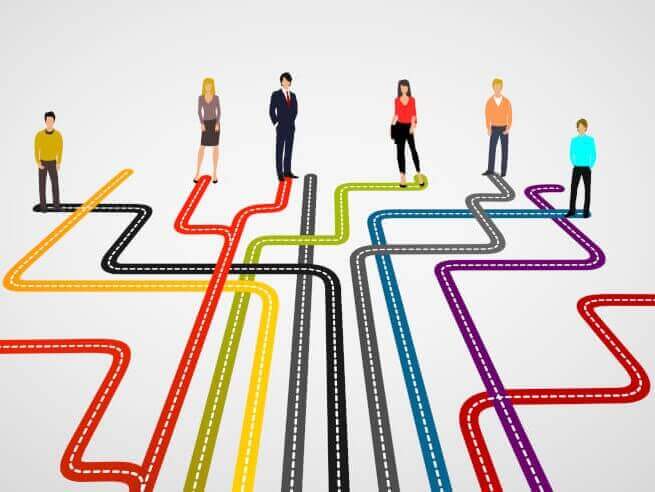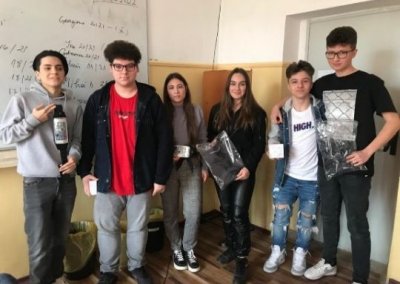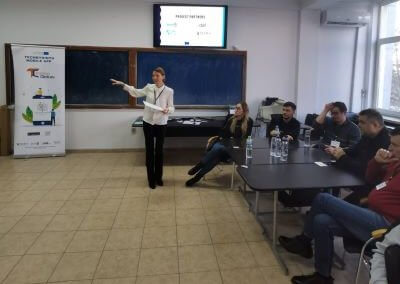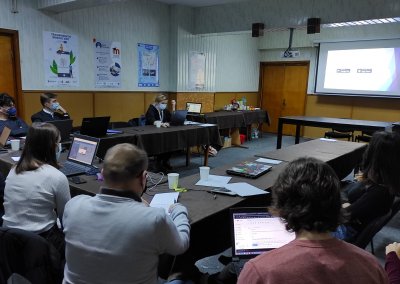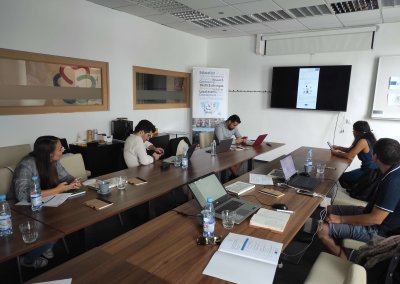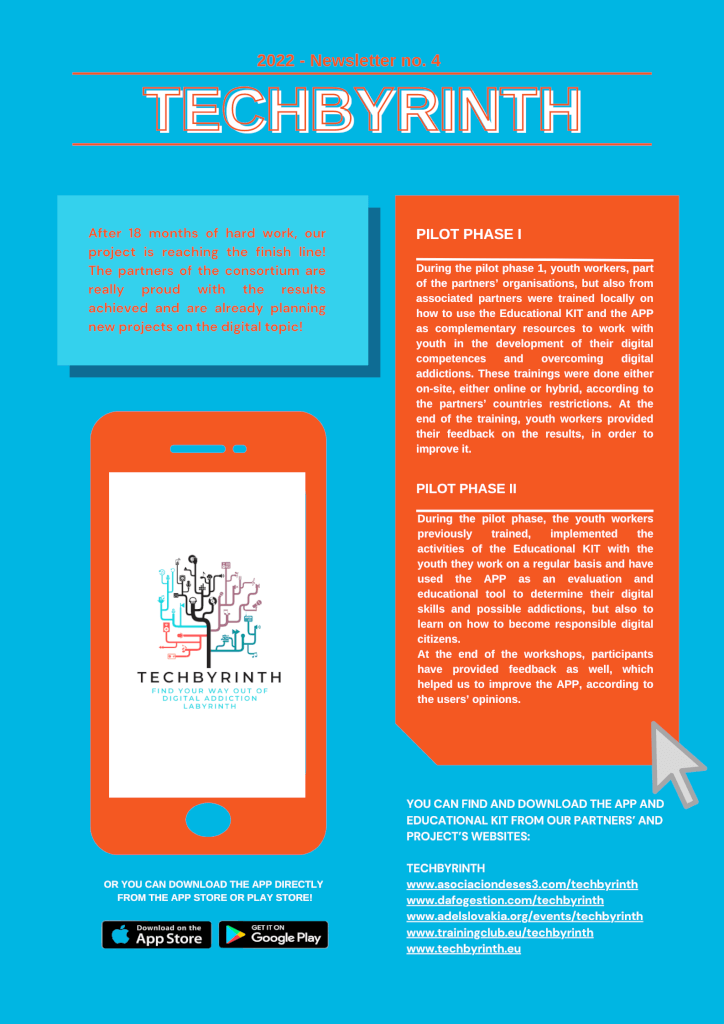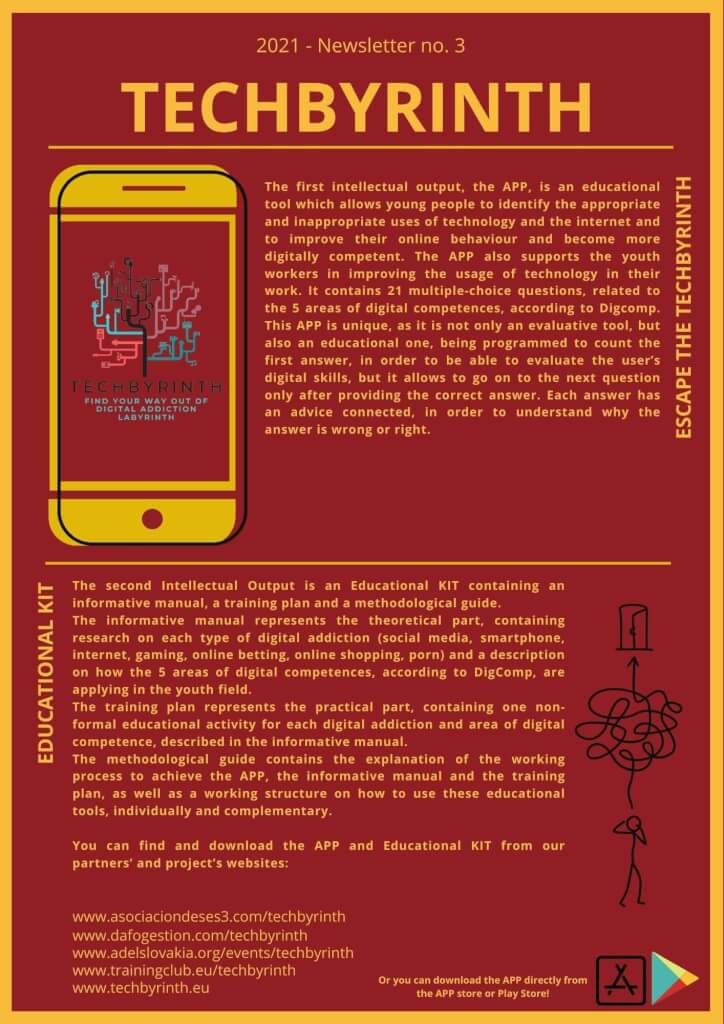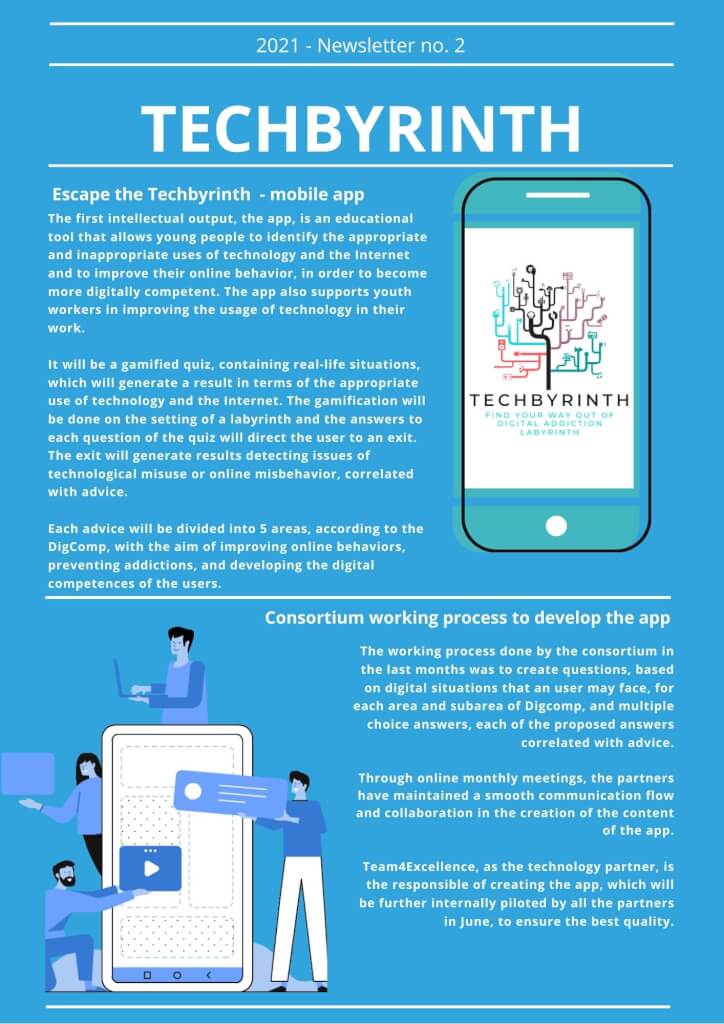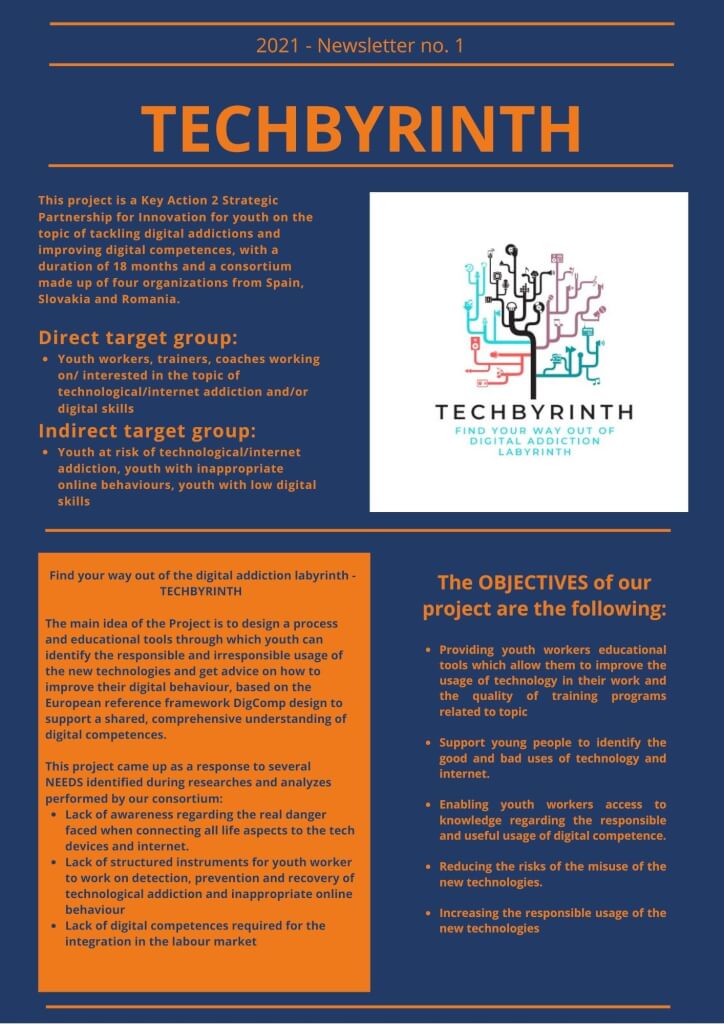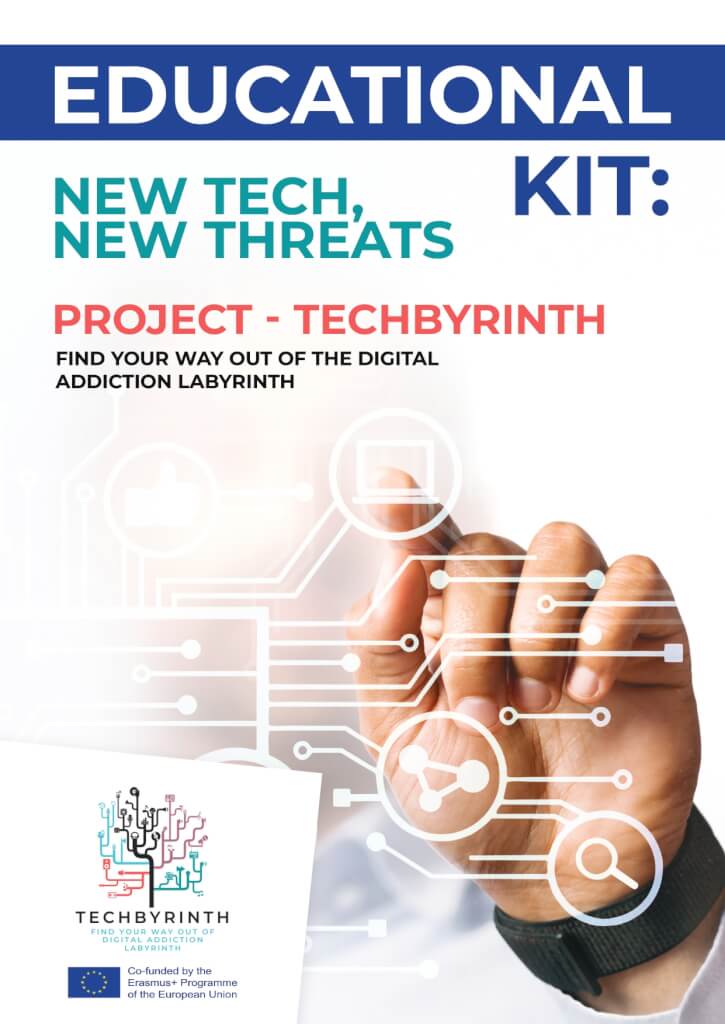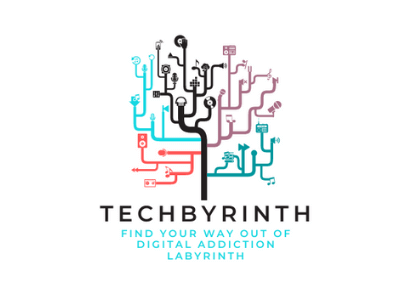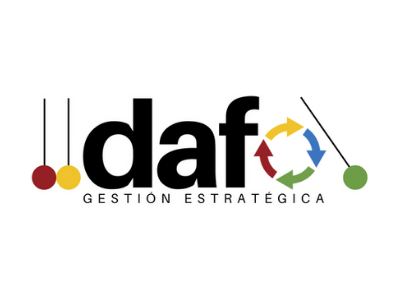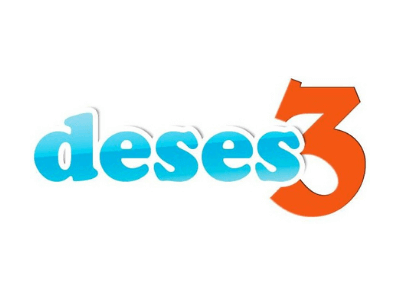DIGITAL ADDICTION LABYRINTH
What is the idea behind it
The main idea of the Project is to design a process and educational tools through which youth can identify the responsible and irresponsible usage of the new technologies and get advice on how to improve their digital behaviour, based on the European reference framework DigComp design to support a shared, comprehensive understanding of digital competences.
Who is this for
Direct target group: youth workers, trainers, coaches working on/ interested in the topic of technological/internet addiction and/or digital skills
Indirect target group: youth at risk of technological/internet addiction, youth with inappropriate online behaviours, youth with low digital skills
Why Techbyrinth
This project came as a response to several NEEDS founded after researches and analyzes performed by our consortium:
• Lack of awareness regarding the real danger faced when connecting all life aspects to the tech devices and internet.
• Lack of structured instruments for youth worker to work on detection, prevention and recovery of technological addiction and inappropriate online behaviour
• Lack of digital competences required for the integration in the labour market
What do we achieve
Main GOAL. Young people to understand what it means to be a good ‘digital citizen’, being able to act responsibly online and to provide a useful and innovative educational tool for youth workers on the topic of digital addictions and competences. The OBJECTIVES of our project are the following: ● Providing youth workers educational tools which allow them to improve the usage of technology in their work and the quality of training programs related to topic ● Support young people to identify the good and bad uses of technology and internet ● Enabling youth workers access to knowledge regarding the responsible and useful usage of digital competence ● Reducing the risks of the misuse of the new technologies ● Increasing the responsible usage of the new technologies
Click here to read the first Newsletter of the project!
What is the technological addiction
TECHNOLOGICAL ADDICTION — called INTERNET ADDICTION, INTERNET USE DISORDER (IUD) or Internet addiction disorder (IAD) — is a fairly new phenomenon. It’s often described by psychologists as a serious problem involving the inability to control use of various kinds of technology, in particular the Internet, smartphones, tablets and social networking sites like Facebook, Twitter and Instagram.
According to a research done by Stanford University, 1 out of every 8 of those surveyed had at least one problem due to too much use of the internet. Moreover, in the 13-17 age demographic, up to 3 out of every 4 children could be considered addicted to the internet. The percentage of 18-24 year olds who would qualify as being addicted to the internet is 71%.
Escape the techbyrinth Mobile APP
The first intellectual output, the APP, is an educational tool which allows young people to identify the appropriate and inappropriate uses of technology and the internet and to improve their online behaviour and become more digital competent. The app also supports the youth workers in improving the usage of technology in their work. It will be a gamified quiz, containing real life situations, which will generate a result in terms of appropriate use of technology and the internet. The gamification will be done on the setting of a labyrinth and the answers of each question of the quiz will direct the user to an exit. The exit will generate results detecting issues of technological misuse or online misbehaviour, correlated with advice. Each advice will be divided into 5 areas, according to the Digcomp, with the aim of improving online behaviours, prevent addictions and developing the digital competences of the users.
Free resource kit
The second intellectual output represents an educational KIT composed by a training plan, an informative manual and a methodological guide. It enables youth workers access to knowledge regarding risk prevention and detection of technological addictions, and online misbehaviours. The educational KIT was structured, englobing 3 educational resources, to provide the necessary resources to create effective and qualitative training on the topic of technological addiction. They are subject to individual use, but as a KIT it is expected to provide all the necessary knowledge and know how related to the topic. The training plan will contain the presentation of the app as a non-formal education method to work in the process of risk detection and prevention and development of digital competences according to Digcomp. Second phase will be the implementation of the training plan dedicated to the youth workers that will enable them to use meaningfully the application in their courses and to raise awareness of the risks associated with the digital addictions. This intellectual output will also generate an informative manual regarding the risks and benefits of the technological, internet and social media usages and the digital competences, based on Digcomp. This manual guarantees the transferability of the intellectual output to other educational areas, and useful for any type of organization working with youth. Moreover, a methodological guide will provide youth workers resources to create their own courses on the topic of technological addictions and to identify the causes and provide solutions on the effects.
Improve your digital competences
DigComp is the European reference framework design to support a shared, comprehensive understanding of digital competences. DigComp 2.0 identifies the key components of digital competence in 5 areas which can be summarised as below
Information and data literacy
To articulate information needs, to locate and retrieve digital data, information and content. To judge the relevance of the source and its content. To store, manage, and organise digital data, information and content.
Communication and collaboration
To interact, communicate and collaborate through digital technologies while being aware of cultural and generational diversity. To participate in society through public and private digital services and participatory citizenship. To manage one’s digital identity and reputation.
Digital content creation
To create and edit digital content to improve and integrate information and content into an existing body of knowledge while understanding how copyright and licences are to be applied. To know how to give understandable instructions for a computer system.
Safety
To protect devices, content, personal data and privacy in digital environments. To protect physical and psychological health, and to be aware of digital technologies for social well-being and social inclusion. To be aware of the environmental impact of digital technologies and their use.
Problem solving
To identify needs and problems, and to resolve conceptual problems and problem situations in digital environments. To use digital tools to innovate processes and products. To keep up-to-date with the digital evolution.
Test your competences and learn at the same time
Events across Europe
We share what works!
Engage with likeminded people!
Our Partners
Find out all the partners which are part of our family!
TECHBYRINTH is a multi-disciplinary and complementary project, led by Asociacion DESES-3, a Spanish NGO active in the youth field to guarantee the integral development of young people. The consortium includes three partners from Romania, Spain and Slovakia. We are the Romanian partners (TEAM4EXCELLENCE), an NGO promoting youth and educators’ mobility, voluntarism and community engagement. DAFO is a consulting and training company from Spain, whose mission is to improve the competitiveness of the European society by developing other organizations. ADEL (Slovakia) creates opportunities for active young people who want to learn something new and gain meaningful experiences.
The European Commission support for the production of this publication does not constitute an endorsement of the contents. The contents reflect the views only of the authors, and the Commission cannot be held responsible for any use which may be made of the information contained therein.
Erasmus+ Strategic Partnership: Find your way out of the digital addiction labyrinth – TECHBYRINTH, ID 2020-2-ES02-KA205-015341


